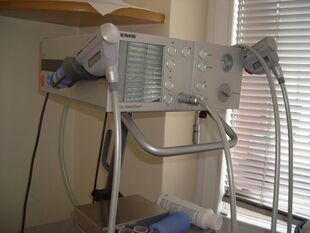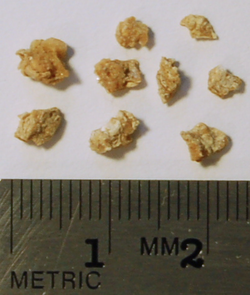Medicine:Extracorporeal shockwave therapy
| Extracorporeal shockwave therapy | |
|---|---|
 ESWT device (EMS Swiss DolorClast) | |
| ICD-10-PCS | 6A93 |
| ICD-9-CM | 98.5 |
Extracorporeal shockwave therapy (ESWT) is a non-invasive, out-patient alternative to surgery for those with many joint and tendon disorders. ESWT sends acoustic shock waves into bone or soft tissue, in effect reinjuring the area on a cellular level and breaking up the scarring that has penetrated tendons and ligaments. The controlled reinjuring of tissue allows the body to regenerate blood vessels and bone cells. The resulting revascularization leads to faster healing and often a return to pre-injury activity levels. ESWT is mostly used for kidney stones removal, in physical therapy and orthopedics.[1]
Medical uses

The most common use of extracorporeal shockwave therapy (ESWT) is for lithotripsy to treat kidney stones[2] (urinary calculosis) and biliary calculi (stones in the gallbladder or in the liver) using an acoustic pulse. It is also reported to be used for salivary stones[3] and pancreatic stones.[4]
In the UK, the National Institute for Health and Care Excellence (NICE) found that the evidence for ESWT in the majority of indications is conflicting, and therefore ESWT should only be used where there are special arrangements for clinical governance and audit.[5] Two 2017 reviews had similar findings, with moderate level evidence at best.[6][7]
Extracorporeal shockwave therapy is used as a second line measure to treat tennis elbow,[8][9] shoulder rotator cuff pain,[10][11] achilles tendinitis,[12][13] plantar fasciitis,[14][15] and greater trochanteric pain syndrome.[16]
ESWT is also used to promote bone healing and treat bone necrosis.[17] It is an effective alternative to surgical treatment of non-healing fractures.[18]
ESWT is used for wound healing and has shown positive results in short-term and long-term outcomes in diabetic patients with foot ulcers.[19] Randomised controlled trials into the use of ESWT for healing venous leg ulcers are needed as there is a lack of evidence in this area.[20]
Procedure
The lithotripter attempts to break up the stone with minimal collateral damage by using an externally applied, focused, high-intensity acoustic pulse. The patient is usually sedated or anesthetized for the procedure in order to help them remain still and reduce possible discomfort.[21] Sedation is not required in its application for soft tissue injuries.
History
Beginning in 1969 and funded by the German Ministry of Defense, Dornier began a study of the effects of shock waves on tissue. In 1972, on the basis of preliminary studies performed by Dornier Medical Systems, an agreement was reached with Egbert Schmiedt, director of the urologic clinic at the University of Munich. The development of the Dornier lithotripter progressed through several prototypes, ultimately culminating in February 1980 with the first treatment of a human by SWL. The production and distribution of the Dornier HM3 lithotripter began in late 1983, and SWL was approved by the U.S. Food and Drug Administration in 1984.[22]
In the 1980s people using ESWT for kidney stones noticed that it appeared to increase bone density in nearby bones, leading them to explore it for orthopedic purposes.[23]
Research
In response to concerns raised by NICE, in 2012 a study called the Assessment of the Effectiveness of ESWT for Soft Tissue Injuries was launched (ASSERT).[5]
As of 2018 use of ESWT had been studied as a potential treatment for chronic prostatitis/chronic pelvic pain syndrome in three small studies; there were short term improvements in symptoms and few adverse effects, but the medium term results are unknown, and the results are difficult to generalize due to low quality of the studies.[24]
Veterinary use
ESWT is commonly used for treating orthopedic problems in horses, including tendon and ligament injuries, kissing spine, navicular syndrome, and arthritis. The evidence for these uses is weak.[23]
Physiotherapy use
ESWT is used in physical therapy for pain reduction, increase in metabolism at the cellular level, revascularisation, and recovering normal muscle tone following various disorders.[25] The use of ESWT was demonstrated in patients with frozen shoulders compared to therapeutic ultrasound with exercises.[26]
Research suggests that ESWT can accelerate the blood flow, facilitating the healing of the inflamed Achilles tendon.[citation needed] In one study involving 23 patients with chronic achilles tendinopathy, 20 reported improvement in their condition and pain scores after ESWT; three saw no change, and none reported any worsening.[27]
See also
References
- ↑ "Shockwave Therapy" (in en-US). Revolve Physiotherapy. Milton, Ontario. 25 July 2018. https://revolvephysio.com/serviceatrevolve/shockwavetherapy/.
- ↑ "Extracorporeal shock wave lithotripsy (ESWL) versus percutaneous nephrolithotomy (PCNL) or retrograde intrarenal surgery (RIRS) for kidney stones". The Cochrane Database of Systematic Reviews 2023 (8): CD007044. August 2023. doi:10.1002/14651858.CD007044.pub4. PMID 37526261.
- ↑ "Salivary duct stones". MedlinePlus Medical Encyclopedia. U.S. National Library of Medicine. https://www.nlm.nih.gov/medlineplus/ency/article/001039.htm.
- ↑ "Pancreatic stone and treatment using ERCP and ESWL procedures: a case study and review". The New Zealand Medical Journal 125 (1361): 89–97. September 2012. PMID 22960720. https://www.nzma.org.nz/journal/read-the-journal/all-issues/2010-2019/2012/vol-125-no-1361/cc-hayes.
- ↑ 5.0 5.1 "Assessment of the Effectiveness of Extracorporeal Shock Wave Therapy (ESWT) For Soft Tissue Injuries (ASSERT): An Online Database Protocol". Translational Medicine @ UniSa 10: 46–51. September 2014. PMID 25147767.
- ↑ "The effectiveness of extracorporeal shockwave therapy in common lower limb conditions: a systematic review including quantification of patient-rated pain reduction". British Journal of Sports Medicine 52 (6): 387–407. March 2018. doi:10.1136/bjsports-2016-097347. PMID 28954794.
- ↑ "Effectiveness of conservative interventions including exercise, manual therapy and medical management in adults with shoulder impingement: a systematic review and meta-analysis of RCTs". British Journal of Sports Medicine 51 (18): 1340–1347. September 2017. doi:10.1136/bjsports-2016-096515. PMID 28630217.
- ↑ "Extracorporeal shockwave therapy for refractory tennis elbow". Interventional procedures guidance. National Institute for Health and Clinical Excellence. August 2009. https://www.nice.org.uk/guidance/ipg313.
- ↑ "Lateral epicondylitis: This is still a main indication for extracorporeal shockwave therapy". International Journal of Surgery 24 (Pt B): 165–170. December 2015. doi:10.1016/j.ijsu.2015.09.034. PMID 26455532.
- ↑ "Extracorporeal shockwave lithotripsy for calcific tendonitis (tendinopathy) of the shoulder". Interventional procedures guidance. National Institute for Health and Clinical Excellence. November 2003. https://www.nice.org.uk/guidance/ipg21.
- ↑ "Evidence for minimally invasive therapies in the management of chronic calcific tendinopathy of the rotator cuff: a systematic review and meta-analysis". Journal of Shoulder and Elbow Surgery 23 (8): 1240–1249. August 2014. doi:10.1016/j.jse.2014.02.002. PMID 24774621.
- ↑ "Extracorporeal shockwave therapy for refractory Achilles tendinopathy". Interventional procedures guidance. National Institute for Health and Clinical Excellence. August 2009. https://www.nice.org.uk/guidance/ipg312.[needs update]
- ↑ "Treatment for insertional Achilles tendinopathy: a systematic review". Knee Surgery, Sports Traumatology, Arthroscopy 21 (6): 1345–1355. June 2013. doi:10.1007/s00167-012-2219-8. PMID 23052113.
- ↑ "Extracorporeal shockwave therapy for refractory plantar fasciitis". Interventional procedures guidance. National Institute for Health and Clinical Excellence. August 2009. https://www.nice.org.uk/guidance/ipg311.
- ↑ "Is extracorporeal shock wave therapy clinical efficacy for relief of chronic, recalcitrant plantar fasciitis? A systematic review and meta-analysis of randomized placebo or active-treatment controlled trials". Archives of Physical Medicine and Rehabilitation 95 (8): 1585–1593. August 2014. doi:10.1016/j.apmr.2014.01.033. PMID 24662810.
- ↑ "Extracorporeal shockwave therapy for refractory greater trochanteric pain syndrome". Interventional procedures guidance. National Institute for Health and Clinical Excellence. January 2011. https://www.nice.org.uk/guidance/ipg376.
- ↑ "Biological mechanism of shockwave in bone". International Journal of Surgery 24 (Pt B): 143–146. December 2015. doi:10.1016/j.ijsu.2015.06.059. PMID 26118613.
- ↑ "[Clinical application of extracorporeal shock wave to repair and reconstruct osseous tissue framework in the treatment of avascular necrosis of the femoral head (ANFH)]" (in zh). Zhongguo Gu Shang = China Journal of Orthopaedics and Traumatology 23 (1): 12–15. January 2010. PMID 20191955.
- ↑ "Extracorporeal shockwave therapy in diabetic foot ulcers". International Journal of Surgery 24 (Pt B): 207–209. December 2015. doi:10.1016/j.ijsu.2015.06.024. PMID 26079500.
- ↑ "Extracorporeal shock wave therapy for the healing and management of venous leg ulcers". The Cochrane Database of Systematic Reviews 2018 (6): CD011842. June 2018. doi:10.1002/14651858.CD011842.pub2. PMID 29889978.
- ↑ "Lithotrypsy" National Kidney Foundation, Accessed February 6, 2017
- ↑ "Gastroenterology and Urology Devices; Reclassification of the Extracorporeal Shock Wave Lithotripter AGENCY: Food and Drug Administration, HHS ACTION: Proposed rule". Federal Register (US Government). February 8, 1999. https://www.fda.gov/ohrms/dockets/98fr/020899a.txt.
- ↑ 23.0 23.1 "A review of the cellular and molecular effects of extracorporeal shockwave therapy". Veterinary and Comparative Orthopaedics and Traumatology 29 (2): 99–107. 2016. doi:10.3415/VCOT-15-04-0057. PMID 26846274.

- ↑ "Non-pharmacological interventions for treating chronic prostatitis/chronic pelvic pain syndrome". The Cochrane Database of Systematic Reviews 2018 (5): CD012551. May 2018. doi:10.1002/14651858.CD012551.pub3. PMID 29757454.
- ↑ "Physical therapy, corticosteroid injection, and extracorporeal shock wave treatment in lateral epicondylitis. Clinical and ultrasonographical comparison". Clinical Rheumatology 31 (5): 807–812. May 2012. doi:10.1007/s10067-012-1939-y. PMID 22278162.
- ↑ "The effectiveness of extracorporeal shockwave therapy for frozen shoulder in patients with diabetes: randomized control trial". Journal of Physical Therapy Science 31 (7): 493–497. July 2019. doi:10.1589/jpts.31.493. PMID 31417208.
- ↑ "Extracorporeal shockwave therapy for the treatment of Achilles tendinopathies: a prospective study". Journal of the American Podiatric Medical Association 98 (6): 466–468. November–December 2008. doi:10.7547/0980466. PMID 19017855.
 |

